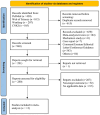Predictive Value of Hepatitis B Core-Related Antigen for Multiple Recurrence Outcomes After Treatment Cessation in Chronic Hepatitis B: A Meta-Analysis Study
- PMID: 40733547
- PMCID: PMC12299212
- DOI: 10.3390/v17070929
Predictive Value of Hepatitis B Core-Related Antigen for Multiple Recurrence Outcomes After Treatment Cessation in Chronic Hepatitis B: A Meta-Analysis Study
Abstract
Background: Hepatitis B core-related antigen (HBcrAg), a novel serum biomarker reflecting the activity of intrahepatic covalently closed circular DNA (cccDNA), has generated conflicting evidence regarding its clinical utility for predicting post-antiviral therapy relapse in chronic hepatitis B (CHB) patients.
Methods: We systematically analyzed 13 studies (15 cohorts, n = 1529 patients) from PubMed, Web of Science, Wanfang, and CNKI (through April 2025). A bivariate model evaluated HBcrAg's predictive performance for relapse outcomes, including virological relapse, clinical relapse, and hepatitis flares.
Results: HBcrAg demonstrated a pooled sensitivity of 0.81 (95% CI: 0.75-0.86) and specificity of 0.72 (95% CI: 0.67-0.76) for relapse prediction, with a diagnostic odds ratio of 10.66 (95% CI: 7.36-15.42) and summary AUC of 0.83 (95% CI: 0.80-0.86). Subgroup analysis identified threshold effects as the primary source of heterogeneity, which resolved (I2 < 13%) after excluding studies with outlier cutoff values. Meta-regression established that HBcrAg's predictive value was unaffected by age, sex, hepatitis B e antigen status, or detection methods (p > 0.05).
Conclusions: HBcrAg is validated as a robust non-invasive biomarker to optimize treatment cessation strategies, with high sensitivity providing strong negative predictive value in CHB populations. Future research should prioritize multi-marker models to enhance prediction accuracy.
Keywords: CHB patients; HBcrAg; meta-analysis; treatment cessation strategy; viral relapse prediction.
Conflict of interest statement
The authors have declared that they have no conflicts of interest.
Figures






Similar articles
-
Hepatitis B virus core-related antigen (HBcrAg) as a prognostic marker for the development of hepatocellular carcinoma: A mini systematic review of the literature.Rev Med Virol. 2022 Nov;32(6):e2353. doi: 10.1002/rmv.2353. Epub 2022 Apr 20. Rev Med Virol. 2022. PMID: 35441759
-
Use of HBV RNA and to predict change in serological status and disease activity in CHB.Hepatology. 2023 Nov 1;78(5):1542-1557. doi: 10.1097/HEP.0000000000000413. Epub 2023 Apr 20. Hepatology. 2023. PMID: 37074026 Free PMC article.
-
Adefovir dipivoxil and pegylated interferon alfa-2a for the treatment of chronic hepatitis B: a systematic review and economic evaluation.Health Technol Assess. 2006 Aug;10(28):iii-iv, xi-xiv, 1-183. doi: 10.3310/hta10280. Health Technol Assess. 2006. PMID: 16904047
-
Overrange dilution for improvement of hepatitis B core related antigen as a biomarker: protocol validation and examples for application.Virology. 2025 Aug;609:110576. doi: 10.1016/j.virol.2025.110576. Epub 2025 May 14. Virology. 2025. PMID: 40393306
-
Predictive role of early treatment dynamics of HBV RNA and HBcrAg for HBeAg seroconversion in children with chronic hepatitis B.J Med Virol. 2024 May;96(5):e29670. doi: 10.1002/jmv.29670. J Med Virol. 2024. PMID: 38773810
References
-
- Hosaka T., Suzuki F., Kobayashi M., Fujiyama S., Kawamura Y., Sezaki H., Akuta N., Kobayashi M., Suzuki Y., Saitoh S., et al. Ultrasensitive Assay for Hepatitis B Core-Related Antigen Predicts Hepatocellular Carcinoma Incidences During Entecavir. Hepatol. Commun. 2022;6:36–49. doi: 10.1002/hep4.1819. - DOI - PMC - PubMed
-
- Caviglia G.P., Armandi A., Rosso C., Ribaldone D.G., Pellicano R., Fagoonee S. Hepatitis B Core-Related Antigen as Surrogate Biomarker of Intrahepatic Hepatitis B Virus Covalently-Closed-Circular DNA in Patients with Chronic Hepatitis B: A Meta-Analysis. Diagnostics. 2021;11:187. doi: 10.3390/diagnostics11020187. - DOI - PMC - PubMed
Publication types
MeSH terms
Substances
Grants and funding
LinkOut - more resources
Full Text Sources
Miscellaneous

